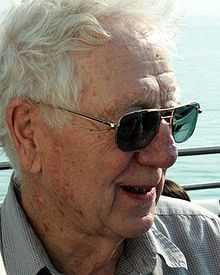Oliver Smithies
| Oliver Smithies | |
|---|---|
 Smithies at the Lindau Nobel Laureate Meeting in 2010 | |
| Born |
June 23, 1925 Halifax, West Yorkshire, England |
| Nationality | United Kingdom, United States |
| Fields | Biochemistry, genetics |
| Institutions |
University of Toronto University of Wisconsin–Madison University of North Carolina at Chapel Hill |
| Alma mater | Balliol College, University of Oxford |
| Known for | Gel electrophoresis, gene targeting |
| Notable awards |
Albert Lasker Award for Basic Medical Research (2001) Wolf Prize in Medicine (2002) Thomas Hunt Morgan Medal (2007) Nobel Prize in Physiology or Medicine (2007) |
Oliver Smithies (born June 23, 1925) is a British-born American geneticist and Nobel laureate,[1] credited with the introduction of starch as a medium for gel electrophoresis in 1955,[2] and the simultaneous discovery, with Mario Capecchi and Martin Evans, of the technique of homologous recombination of transgenic DNA with genomic DNA, a much more reliable method of altering animal genomes than previously used, and the technique behind gene targeting and knockout mice.
Early life
Smithies was born in Halifax, West Yorkshire, England. He has said that his love of science comes from an early fascination with radios and telescopes.[3]
Smithies read Physiology for a BA First class 1946 and then earned a second bachelor's degree in chemistry.[4] He also received a MA 1951 and a DPhil in Biochemistry in 1951 at Balliol College, Oxford. On scholarship to Oxford, Smithies dropped out of medical school to study chemistry instead.[3]
Professional positions and research

Because of a visa problem, from 1953 to 1960 Smithies was an associate research faculty member in the Connaught Medical Research Laboratory at the University of Toronto in Canada,[3] before he could return to his originally planned post as Assistant, Associate and Leon J. Cole and Hilldale Professor of Genetics and Medical Genetics at the University of Wisconsin–Madison, where he worked from 1960 to 1988.[3] It was at Toronto's Connaught Laboratory that Smithies developed the technique of gel electrophoresis.
Since 1988, Smithies has been designated an Excellence Professor of Pathology and Laboratory Medicine at the University of North Carolina at Chapel Hill in the United States.[5]
Smithies' work has advanced research in cystic fibrosis and could possibly have applications in other human diseases.[6] Along with gel electrophoresis, he developed gene targeting, a method of generating mice with more human-like characteristics for use in research.
He and Mario Capecchi both came to the same discoveries regarding gene targeting independently.[5] Smithies developed the technique while at the University of Wisconsin.
In 2002, Smithies worked along with his wife, Dr. Nobuyo Maeda, studying high blood pressure using genetically altered mice.[5] As of 2008, he still worked in his lab seven days a week.[7]
Awards and honors
On October 8, 2007, Smithies was announced as co-winner of the Nobel Prize in Physiology or Medicine with Mario Capecchi of the University of Utah and Martin Evans of Cardiff University "for their discoveries of principles for introducing specific gene modifications in mice by the use of embryonic stem cells." Smithies is the first full professor at the University of North Carolina-Chapel Hill to receive a Nobel Prize.[6] Previous awards and honors received by Oliver Smithies include:
- 1971 – Elected to the United States National Academy of Sciences.
- 1978 – Elected to the American Academy of Arts and Sciences.
- 1986 – Elected Fellow of the American Association for the Advancement of Science.
- 1990 – Smithies received the Gairdner Foundation International Award for contributions to medical science. The award is often considered a precursor to the Nobel Prize in Medicine, and Smithies won it twice.[8] He also won the Alfred P. Sloan Award from the General Motors Foundation, the Ciba Award from the American Heart Foundation and the Bristol Myers Squibb Award.[8]
- 1991 – Smithies was given an honorary degree by the University of Chicago.[9]
- 1993 – He won the North Carolina Award for Science.[10]
- 1996-2013 – March of Dimes Prize in Developmental Biology[11]
- 1998 – American Association of Medical Colleges' Award for Distinguished Research was awarded to Smithies and Capecchi.
- 1998 – Elected Foreign Member of the Royal Society.
- 2000 – Smithies won the International Okamoto Award from the Japan Vascular Disease Research Foundation in 2000, a prize with one million yen ($10,000); he accepted the award at the Gion Festival in Japan.[12]
- 2001 – Smithies was a recipient of the Albert Lasker Award for Basic Medical Research with Martin Evans and Mario Capecchi for their work on homologous recombination; the award is often seen as an "American Nobel."[13]
- 2002 – Smithies was given the O. Max Gardner Award, the highest award for faculty in the University of North Carolina system, along with the 2002 Massry Award shared with Capecchi for their pioneering work on genes. The Massry Prize is awarded by the Meira and Shaul G. Massry Foundation of Beverly Hills, California, and the winner receives $40,000 along with a gold medal.[5]
- 2003 – Smithies was elected to the U.S. Institute of Medicine, one of the highest honors given to U.S. health professionals.[8]
- 2003 – Smithies received the Wolf Prize in Medicine, the third most prestigious award in medicine, along with Mario Capecchi and Ralph L. Brinster.
- 2005 – The USA charity, March of Dimes, awarded their $250,000 annual prize in Developmental Biology jointly to Smithies and Mario Capecchi for their research in gene targeting.[14]
- 2008 – The University of São Paulo (Portuguese: Universidade de São Paulo) rector, Suely Vilela, awarded Smithies with a Doctor Honoris Causa title on September, 18th.[15]
- 2009 - Awarded American Institute of Chemists Gold Medal[16]
- 2011 – The University of Oxford awarded Smithies with a Doctor Honoris Causa title on June, 29th during the annual Encaenia ceremony.[17]
Personal life
Smithies is now a naturalized American citizen,[18] and, despite being color-blind, is a licensed private airplane pilot who enjoys gliding.[3][4] His wife, Nobuyo Maeda, is a pathology professor at University of North Carolina.[4] He was previously married to Lois Kitze, a scientist at the University of Wisconsin.[4]
References
- ↑ "The Nobel Prize in Physiology or Medicine 2007". The Nobel Foundation. Retrieved October 8, 2007.
- ↑ Smithies, Oliver (December 1955). "Zone electrophoresis in starch gels: group variations in the serum proteins of normal human adults". The Biochemical Journal 61 (4): 629–641. ISSN 0264-6021. PMC 1215845. PMID 13276348.
- ↑ 3.0 3.1 3.2 3.3 3.4 Altman, Lawrence K. (October 9, 2007). "3 Win Nobel in Medicine for Gene Technology". New York Times. Retrieved October 10, 2007.
- ↑ 4.0 4.1 4.2 4.3 Kolata, Gina (October 17, 1995). "Scientist at Work: Oliver Smithies; Sprinting Along for Five Decades". New York Times. Retrieved October 10, 2007.
- ↑ 5.0 5.1 5.2 5.3 "Smithies wins top award from Massry Foundation". University of North Carolina at Chapel Hill News Service. Retrieved October 10, 2007.
- ↑ 6.0 6.1 "UNC professor wins Nobel Prize". The Daily Tarheel. Retrieved October 9, 2007.
- ↑ "Life at the Bench". Endeavors magazine. Retrieved September 6, 2011.
- ↑ 8.0 8.1 8.2 "Institute of Medicine elects Oliver Smithies". University of North Carolina at Chapel Hill News Service. Retrieved October 10, 2007.
- ↑ "Commencements; First Lady Urges Tolerance at Northeastern Graduation". New York Times. June 16, 1991. Retrieved October 10, 2007.
- ↑ North Carolina Award for Science, 1993: NC Awards website. Retrieved on January 23, 2008.
- ↑ "March of Dimes Prize in Developmental Biology". March of Dimes. Retrieved October 29, 2014.
- ↑ "Oliver Smithies wins major award from Japanese research foundation". University of North Carolina at Chapel Hill News Service. Retrieved October 10, 2007.
- ↑ "2001 Albert Lasker Award for Basic Medical Research". Lasker Foundation. Archived from the original on September 30, 2007. Retrieved October 1, 2007.
- ↑ "March of Dimes Awards $250,000 Prize to Pioneers in Genetic Research". March of Dimes. Retrieved November 14, 2014.
- ↑ "Oliver Smithies receives the Doctor Honoris Causa". University of São Paulo. Retrieved September 20, 2008.
- ↑ "Gold Medal Award Winners:". American Institute of Chemists. Retrieved 18 January 2015.
- ↑ "Honorary degrees awarded at Encaenia". University of Oxford. Retrieved May 16, 2013.
- ↑ "'The y-chromosome is the biggest threat to humanity'". The Local. Retrieved January 23, 2008.
External links
- Smithies' Lab Page
- Smithies Nobel Prize lecture
- Nobel Prize Inspiration Initiative
- Lasker Award details
- Text of Smithies' Interview about Lasker Award
- List of prize winners on March of Dimes website
- UNC Press release of Smithies' election to Institute of Medicine
- UNC Press release of Smithies' receipt of the O. Max Gardner Award
- Lecture on the 64th Lindau Nobel Laureate's Meeting - "Oliver Smithies (2014) : Where Do Ideas Come From?"
| ||||||||||||||||||||||||
|
